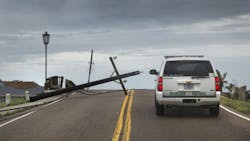The Energy Information Administration (EIA) is warning that current prices for diesel and gasoline “do not yet reflect the full effects of Hurricane Harvey” and that the devastation caused by that storm “casts a great deal of uncertainty regarding what may happen over the next few weeks.”
Though the U.S. retail average gasoline price hit $2.40 per gallon on August 28 – the second-lowest price on the Monday before Labor Day since 2004 – and while Monday’s price was up 4 cents per gallon over the previous week, that foes not does yet reflect the impact of refinery shut downs due to Hurricane Harvey.
“The Texas Gulf Coast [where Harvey made landfall August 25] alone is home to over 25% of U.S. refining capacity, and the U.S. federal offshore [production regions] in the Gulf of Mexico accounts for nearly 20% of total U.S. crude oil production,” the agency said.
“However, Hurricane Harvey has impacted crude oil production and refinery operations in the region,” EIA stressed. “A number of refineries have shut down or are operating at reduced rates. Electrical power, ability of personnel to reach the refineries, and distribution of crude oil and petroleum products remain potential challenges to quickly restarting the refineries.”This may have notable impacts on gasoline prices in the region, which could spread to other markets, the agency said – particularly the East Coast, which is largely dependent on shipments of transportation fuels from the Gulf Coast.
Already, gasoline prices in the U.S. have hit $2 per gallon for the first time since 2015, according to Reuters, as flooding from Harvey knocked out almost a quarter of U.S. refineries, while the storm moves inland over Louisiana.
"While no two natural disasters are similar, the precedent of [Hurricanes] Rita-Katrina suggests that 10% of the currently offline capacity could remain unavailable for several months," added Goldman Sachs & Co. in a research note.
Meanwhile, diesel prices are holding steady for now, EIA said, though they are much higher in comparison to the same period last year.
The U.S. average diesel fuel price increased a penny to $2.61 per gallon on August 28, which is 20 cents higher than a year ago, according to the agency’s data.
The West Coast price for diesel increased three cents to $2.91 per gallon, the Gulf Coast price rose two cents to $2.43 per gallon, the East Coast price increased nearly one cent, remaining at $2.62 per gallon, and the Rocky Mountain region witnessed a jump of less than one cent to $2.72 per gallon. The Midwest price fell less than one cent, remaining at $2.57 per gallon.
About the Author
Sean Kilcarr
Editor in Chief
Sean Kilcarr is a former longtime FleetOwner senior editor who wrote for the publication from 2000 to 2018. He served as editor-in-chief from 2017 to 2018.

